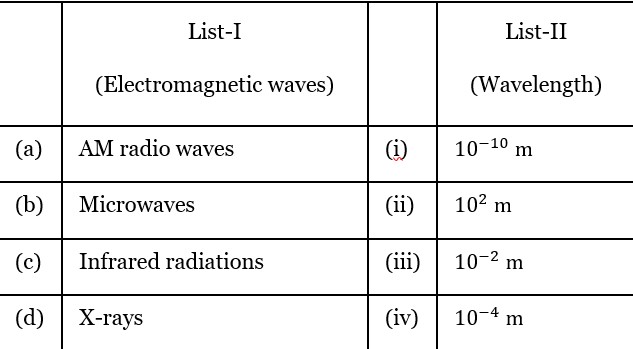Physics Electromagnetic Waves
Get insights from 81 questions on Physics Electromagnetic Waves, answered by students, alumni, and experts. You may also ask and answer any question you like about Physics Electromagnetic Waves
Follow Ask QuestionQuestions
Discussions
Active Users
Followers
New answer posted
2 months agoContributor-Level 9
(a) Radio wave (ii)
(ii)
(b) Microwave
(iii)
(iii)
(c) Infrared radiations (iv) (iv)
(d) - ray (i) (i)
(a) - (ii), (b) - (iii), (c) - (iv), (d) - (i)
New answer posted
2 months agoContributor-Level 10
d_lm = Distance covered by transmitting antenna + Distance covered by receiving antenna
⇒ d_lm = √ (2Rh_transmitting) + √ (2Rh_receiving)
⇒ d_lm = √ (2 * 64 * 10? * 20) + √ (2 * 64 * 10? * 5) = 16000 + 8000 = 24000m
When h_receiving = 0 then
d_2m = √ (2 * 64 * 10? * 20) = 16000m
% increment = (8000/16000) * 100 = 50
New answer posted
2 months agoContributor-Level 10
As we know that direction of propagation of electromagnetic wave is perpendicular to plane containing mutually perpendicular electric field and magnetic field, so option D will be correct answer.
New answer posted
2 months agoContributor-Level 10
Electric field squared is proportional to the power P of the bulb (E² ∝ P).
(E' / E)² = (60 / 100) ⇒ E' = E * √* (3/5)*
New answer posted
2 months agoContributor-Level 9
Direction of E is perpendicular to the direction of propagation and that of B.
E = cB = 3 * 10? * 2 * 10? = 6 V/m
New answer posted
2 months agoContributor-Level 10
The force (F) exerted by radiation is the rate of change of momentum (p).
F = Δp/Δt
For photons, p = E/c. So, F = (1/c) * (ΔE/Δt).
Since Power (P) is ΔE/Δt, F = P/c.
Intensity (I) is Power per unit Area (P/A).
The formula provided in the document is F/A = (nE)/ (Δt c A) which leads to a final calculated value of 25 W/cm².
New question posted
2 months agoNew question posted
2 months agoTaking an Exam? Selecting a College?
Get authentic answers from experts, students and alumni that you won't find anywhere else
Sign Up on ShikshaOn Shiksha, get access to
- 65k Colleges
- 1.2k Exams
- 679k Reviews
- 1800k Answers

